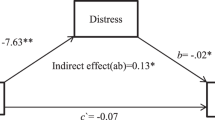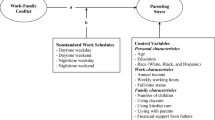Abstract
In Italy, there has been strong cultural support for motherhood as the ideal female role. As increasing numbers of Italian mothers enter the workforce, little is known about the effects of maternal employment. An examination of parenting stress that included work status and Type A Behavior Pattern (TABP) was conducted with 174 employed and at-home mothers in Italy. Higher TABP was associated with higher maternal stress in employed mothers and more stressful parent-child interactions for at-home mothers. The strength of the relationship between parenting stress and TABP varies by maternal work status and parenting stress domain. Considering these results, personality characteristics that are incongruent with feminine gender schema may be especially relevant to the prediction of parenting stress.
Similar content being viewed by others
References
Abidin, R. (1990). Parenting Stress Index-Short Form Manual. Charlottesville, VA: Pediatric Press.
Amatea, E. S. & Fong, M. L. (1991). The impact of role stressor and personal resources on the stress experience of professional women. Psychology of Women Quarterly, 15, 419-430.
Anastopoulos, A. D., Guevremont, D. C., Shelton, T. L. & DuPaul, G. J. (1992). Parenting stress among families of children with attention deficit hyperactivity disorder. Journal of Abnormal Child Psychology, 20, 503-520.
Attanasio, V., Andrasik, F., Blanchard, E. B. & Arena, J. G. (1984). Psychometric properties of the SUNYA revision of the Psychosomatic Symptom Checklist. Journal of Behavioral Medicine, 7, 245-259.
Baker, D. B. (1994). Parenting stress and ADHD: A comparison of mothers and fathers. Journal of Emotional and Behavioral Disorders, 2, 46-50.
Barnett, R. C. & Marshall, N. L. (1992). Worker and mother roles, spillover effects, and psychological distress. Women & Health, 18, 9-40.
Baydar, N., Greek, A. & Gritz, R. M. (1999). Young mothers' time spent at work and time spent caring for children. Journal of Family and Economic Issues, 20, 61-84.
Becker, P. T., Engelhardt, K. F., Steinmann, M. F. & Kane, J. (1997). Infant age, context and family system influences on the interactive behavior of mothers of infants with mental delay. Research in Nursing and Health, 20, 39-50.
Belsky, J. & Rovine, M. J. (1988). Nonmaternal care in the first year of life and the security of infant-parent attachment. Child Development, 59, 157-167.
Berardo, D. H., Shehan, C. L. & Leslie, G. R. (1987). A residue of tradition: Jobs, careers, and spouses' time in housework. Journal of Marriage and the Family, 49, 381-390.
Bimbi, F. (1992). Parenthood in Italy: Asymmetric relationships and family affection. In U. Bjornberg (Ed.) European Parents in the 1990s. pp. 141-154. London (U.K.): Transaction.
Chordorow, N. (1978). The reproduction of mothering: Psychoanalysis and the sociology of gender. Berkeley, CA: University of California Press.
Conger, R. D., Lorenz, F. O., Elder, G. H., Simons, R. L. & Ge, X. (1993). Husband and wife differences in response to undesirable life events. Journal of Health & Social Behavior, 34, 71-88.
Copeland, A. (1990). Behavioral differences in the interactions between Type A and B mothers and their children. Behavioral Medicine, Fall, 111-117.
Corsaro, W. A. & Emiliani, F. (1992). In M. Lamb, K. Sternberg, C. P. Hwang, & A. G. Broberg (Eds.) Child care in context pp. 81-118. Hillsdale, NJ: Lawrence Erlbaum Associates.
Culbertson, F. M., Comunian, A. L., Farence, S., Fukuhara, M., Halpern, E., Miao, E. S., Muhlbauer, V., O'Roark, & Thomas, A. (1992). Stresses, strains, and adaptive responses in professional women: Cross-cultural reports. In U. P. Gielen & L. Adler (Eds.) Psychology in International Perspective. pp. 281-298. Amersterdam: Swets & Zeitlinger.
Dohrenwend, B., Levav, I., Shrout, P. E., Schwartz, S., Navah, G., Link, B. G., Skodol, A. E., Stueve, A. (1992). Socioeconomic status and psychiatric disorders: The causation-selection issue. Science, 255, 946-952.
Facione, N. C. (1994). Role overload and health: The married mother in the waged labor force. Health Care for Women International, 15, 157-167.
Forgays, D. G., Bonaiuto, P., Wrzesniewski, K. & Forgays, D. K. (1993). Personality and cigarette smoking in Italy, Poland and the United States. The International Journal of the Addictions, 28, 399-414.
Forgays, D. G., Forgays, D. K., Guarino, A., & Bonaiuto, P. (1993). A cross-national comparison of the AATABS-R measure of the Type A Behavior Pattern. Unpublished manuscript, Univ. of Vermont.
Forgays, D. K. (1992). Type A Behavior and parenting stress in mothers with young children. Current Psychology, 11, 3-19.
Forgays, D. K., Forgays, D. G., Bonaiuto, P. & Wrzesniewski, K., (1993). Measurement of the Type A Behavior Pattern from adolescence through midlife: Further development of the Adolescent/Adult Type A Behavior Scale (AATABS). Journal of Behavioral Medicine, 16, 523-537.
Furnham, A. & Voli, V. (1989). Gender stereotypes in Italian television advertisements. Journal of Broadcasting & Electronic Media, 33, 175-185.
Gottfried, A. E., Gottfried, A. W. & Killian, C. (1999). Maternal and dual-earner employment. In M. Lamb (Ed.) Parenting and Child Development in Nontraditional Families. pp. 15-37. Mahwah, NJ: Lawrence Erlbaum Associates.
Gove, W. R. & Geerken, M. R. (1977). The effect of children and employment on the mental health of married men and women. Social Forces, 56, 66-76.
Harralson, T. & Lawler, K. (1992). The relationship of parenting styles and social competency to Type A Behavior in children. Journal of Psychosomatic Research, 36, 625-634.
Harvey, E. (1999). Short term and long term effects of parental employment. Developmental Psychology, 35, 445-459.
Haynes, S. G., Levine, S., Scotch, N., Feinleib, M. & Kannel, W. B. (1978). The relation ship of psychosocial factors to coronary heart disease in the Framingham Study. American Journal of Epidemiology, 107, 362-383.
Haynes, S. G. & Matthews, K. A. (1988). Area Review: Coronary-prone behavior: Continuing evolution of the concept. Annals of Behavioral Medicine, 10, 47-59.
Hock, E. & Demeis, D. K. (1990). Depression in mothers of infants: The role of maternal employment. Developmental Psychology, 26, 285-291.
Houston, B. K. & Snyder, C. R. (Eds.) (1988). Type A Behavior Pattern: Research, theory and intervention. New York: Wiley.
Jaccard, J., Turrisi, R. & Wan, C. K. (1990). Interaction effects in multiple regression. Newberry Park, CA: Sage.
Joesch, J. M. (1998). Where are the children? Extent and determinants of preschoolers' child care time. Journal of Family and Economic Issues, 19, 75-99.
Kahn, H. & Cuthbertson, J. (1998). A comparison of the self-reported mental and physical stress of working and full-time homemaker mothers-a UK pilot study. Stress Medicine, 14, 149-154.
Kibria, N., Barnett, R. C., Baruch, G. K., Marshall, N. L. & Pleck, J. H. (1990). Homemaking-role quality and the psychological well-being and distress of employed women. Sex Roles, 22, 327-347.
Lamb, M. (Ed.) (1999). Parenting and child development in “nontraditional” families. Mahwah, NJ: Lawrence Erlbaum.
Lin, N. & Ensel, W. (1989) Life stress and health: Stressors and Resources. American Sociological Review, 54, 382-99.
Loyd, B. & Abidin, R. (1985). Revision of the Parenting Stress Index. Journal of Pediatric Psychology, 10, 169-177.
Manetti, M. & Schneider, B. H. (1996). Stability and change in patterns of parental social support and their relation to children's school adjustment. Journal of Applied Developmental Psychology, 17, 101-115.
Matthews, K. A., Weiss, S. M., Detre, T., Dembroski, T.M., Falkner, B., Manuck, S. B. & Williams, R. (Eds.) (1986). Handbook of stress, reactivity and cardiovascular disease. New York: Wiley.
McBride, A. (1990). Mental health effects of women's multiple roles. American Psychologist, 45, 381-384.
Merenda, R. & Mattioni, M. (1993). Italy. In L.L. Adler (Ed.) International Handbook on Gender Roles. (pp. 159-173) Westport, CT: Greenwood Press.
Orthner, D. K. & Neenan, P. A. (1996). Children's impact on stress and employability of mothers in poverty. Journal of Family Issues, 17, 667-687.
Pedhazur, E. J. (1997). Multiple Regression in Behavioral Research, 3rd Edition. (pp. 560-627). New York: Harcourt Brace.
Piechowski, L. D. (1992). Mental health and women's multiple roles. Families in Society: The Journal of Contemporary Human Services, March, 131-139.
Raikkonen, K. & Keltikangas-Jarvinen, L. (1992). Mothers with hostile, Type A predisposing child-rearing practices. Journal of Genetic Psychology, 153, 343-354.
Rutter, M. (1981). Stress, coping and development: Some issues and some questions Journal of Child Psychology and Psychiatry, 22, 323-326.
Scarr, S. (1998). American child care today. American Psychologist, 53, 95-108.
Silverstein, L. B. (1991). Transforming the debate about childcare and maternal employment. American Psychologist, 46, 1025-1032.
Sorensen, G., Jacobs, D. R., Pirie, P., Folsom, A., Luepker, R. & Gillum, R. (1987). Relationships among Type A behavior, employment experiences and gender: The Minnesota Heart Survey. Journal of Behavioral Medicine, 10, 323-336.
Spitze, G. (1988). Women's employment and family relations: A review. Journal of Marriage and the Family, 50, 595-618.
Surrey, J. (1991). The self-in-relation: A theory of women's development. In J. Jordan et al. (Eds.). Women's Growth in Connection: Writings from the Stone Center, New York: Guilford.
Teti, D. M., Gelfand, D. M. & Pompa, J. (1990). Depressed mothers' behavioral competence with their infants: Demographic and psychosocial correlates. Development and Psychopathology, 2, 259-270.
Thompson, R. J., Gustafson, K. E., Oehler, J. M. & Catlett, A. T. (1997). Developmental outcome of very low birth weight infants at four years of age as a function of biological risk and psychosocial risk. Journal of Developmental and Behavioral Pediatrics, 18, 91-96.
Thoresen, C. & Graff Low, K. (1990). Women and the Type A Behavior Pattern: Review and commentary. Journal of Social Behavior and Personality, 5, 117-133.
Tolman, A. E., Diekman, K. A. & McCartney, K. (1989). Social connectedness and mothering: Effects of maternal employment and maternal absence. Personality Processes and Individual Differences, 56,942-949.
U.S. Bureau of Labor Statistics. (2000). Labor force status of mothers by age of youngest child, March 1975-1999. Washington D.C.
U.S. Census Bureau. (1999). International Data Base; laborsta.ilo.org/cgi-bin/broker. exe.
Vandewater, E.A., Ostrove, J.M. & Stewart, A.J. (1997). Predicting women's well-being in midlife: The importance of personality development and social role involvements. Journal of Personality and Social Psychology, 72, 1147-1160.
Vianello, M., Siemienska, R., Damian, N., Lupri, E., Coppi, R., D'Arcangelo, E., & Bolasco, S. (1990). Gender Inequality. London: Sage.
Voydanoff, P. & Donnelly, B. W. (1989). Work and family roles and psychological distress. Journal of Marriage and the Family, 51, 923-932.
Vroege, J. A. & Aaronson, N. K. (1994). Type A Behavior and social support among employed women. Behavioral Medicine, 19, 169-173.
Wrzesniewski, K., Forgays, D. G. & Bonaiuto, P. (1990). Measurement of the Type A Behavior Pattern in adolescents and young adults: Cross-cultural development of AATAB. Journal of Behavioral Medicine, 13, 111-135.
Author information
Authors and Affiliations
Rights and permissions
About this article
Cite this article
Forgays, D.K., Ottaway, S.A., Guarino, A. et al. Parenting Stress in Employed and At-Home Mothers in Italy. Journal of Family and Economic Issues 22, 327–351 (2001). https://doi.org/10.1023/A:1012703227992
Issue Date:
DOI: https://doi.org/10.1023/A:1012703227992




